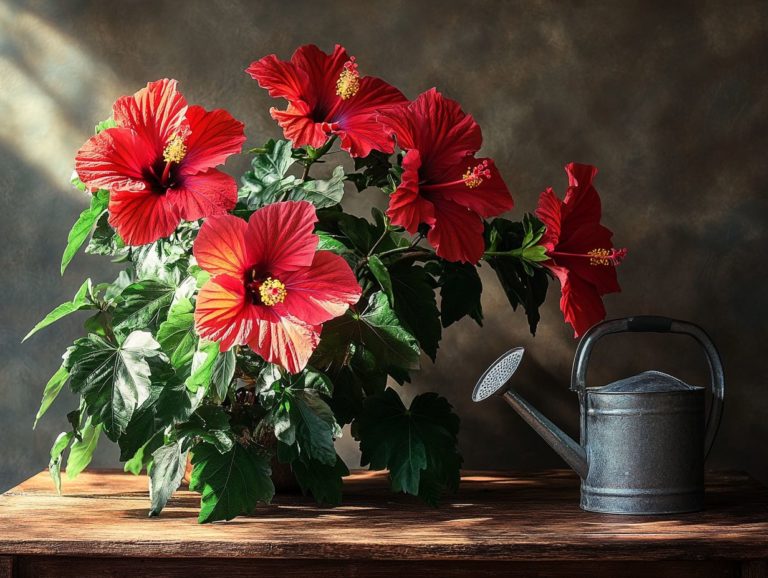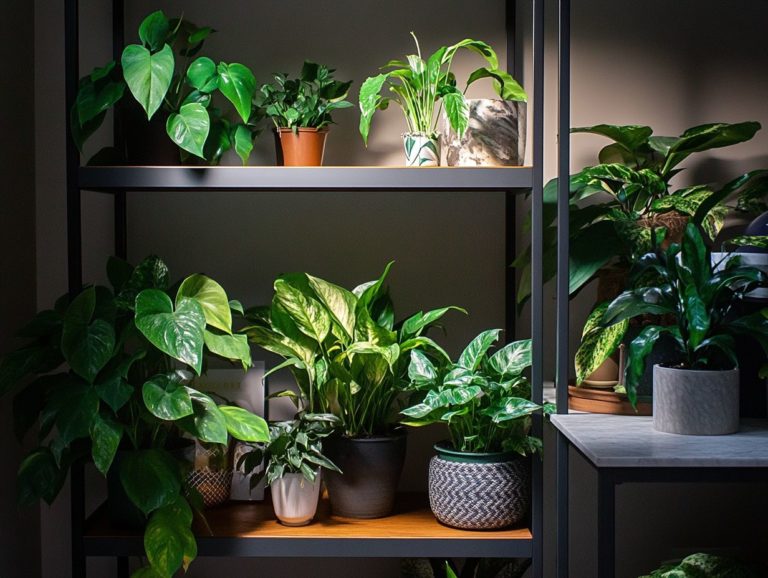The Ultimate Guide to ZZ Plants
ZZ Plants, renowned for their glossy leaves and remarkable resilience, have captured the hearts of houseplant enthusiasts everywhere.
This guide equips you with all the essential knowledge needed for nurturing and caring for these beautiful plants. You’ll delve into their light and water requirements, soil preferences, and effective pest management strategies.
You will discover many benefits they provide, including their impressive air-purifying qualities, along with innovative ideas for seamlessly incorporating them into your home decor.
Get ready to transform your indoor space with these stunning plants!
Contents
Key Takeaways:
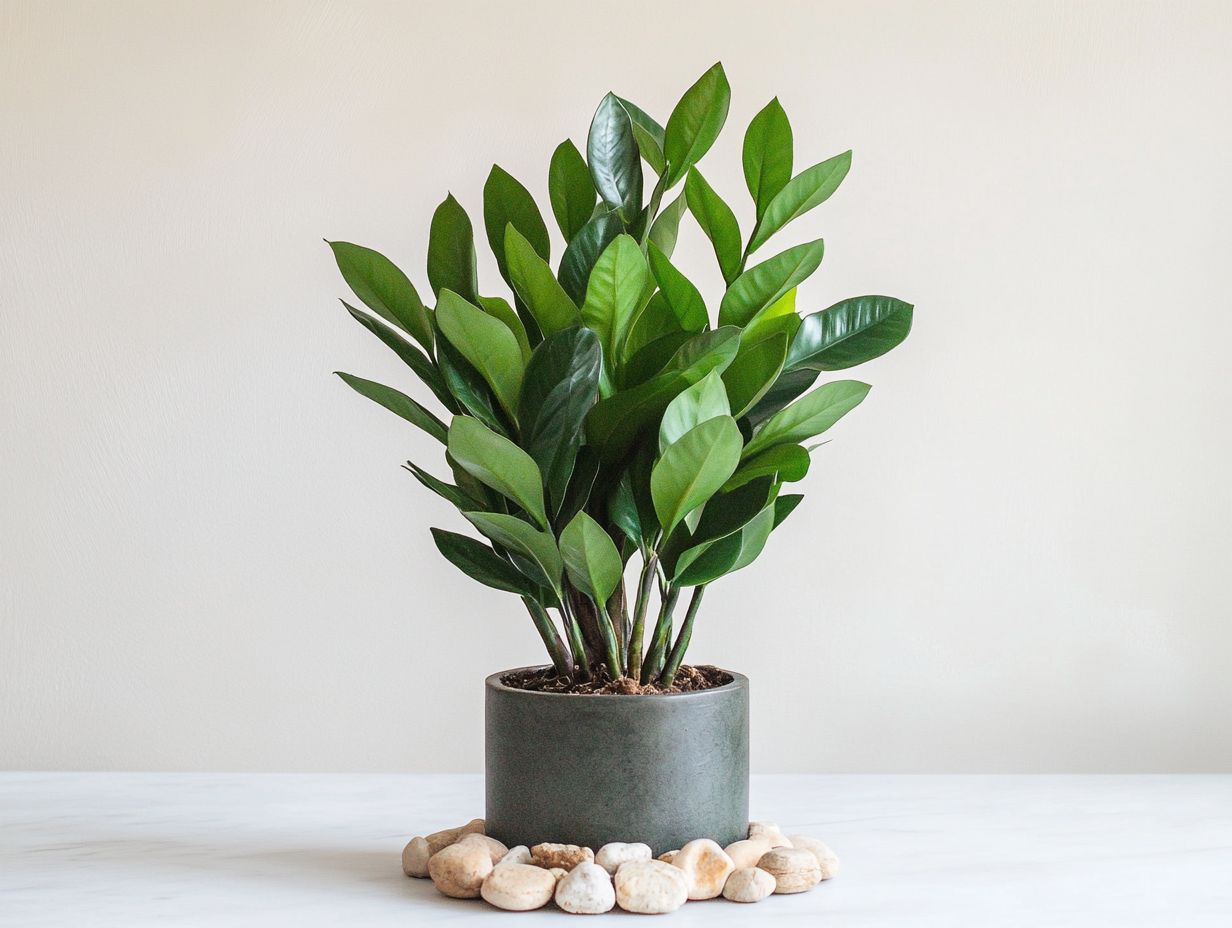
- ZZ Plants are low-maintenance, can survive without much water, and thrive in low light, making them perfect for beginners.
- Proper watering, well-draining soil, and occasional fertilizing can ensure the health and longevity of your ZZ Plant.
- ZZ Plants not only add beauty to your home, but they also purify the air and have health benefits such as reducing stress and improving sleep.
What are ZZ Plants?
ZZ Plants, or Zamioculcas zamiifolia if you want to impress your friends, are the ultimate resilient houseplants, originally from Eastern Africa.
You ll appreciate their striking glossy leaves and sturdy stems, which have made them a staple among indoor gardening enthusiasts.
Their low-maintenance nature means you can enjoy lush greenery without the constant fuss, making them perfect whether you re just starting out or a seasoned plant aficionado.
These remarkable plants can adapt to low-light areas and are incredibly forgiving if you happen to neglect them a bit.
They require minimal watering and care, which is a breath of fresh air. Not only do their unique features elevate your space aesthetically, but they also enhance air quality, making them a smart addition to both homes and offices.
Whether you choose to place your ZZ Plant in a dim corner or showcase it in a bright living room, its easy-care characteristics make it a versatile choice for any indoor setting.
Their resilience and ability to thrive with minimal supervision have made them a go-to for anyone wanting to add a touch of greenery without the hassle.
Growing and Caring for ZZ Plants
Growing and nurturing ZZ Plants offers a truly rewarding experience.
These remarkable, low-maintenance plants effortlessly adapt to a variety of indoor settings, allowing you to enjoy their beauty without the need for constant attention.
Light and Water Requirements
ZZ Plants thrive in bright, indirect light, but they re also quite forgiving and can handle lower light conditions, making them a fantastic choice for various indoor settings.
This adaptability allows them to flourish in everything from sunlit living rooms to the more shaded nooks of your office.
For the best results, place them where they can soak up plenty of bright, indirect light.
In terms of watering, take a gentle approach; overwatering, a condition where roots decay due to excess moisture, can swiftly lead to root rot, which is the nemesis of these otherwise hardy plants.
By using well-draining soil, which allows water to pass through easily, preventing roots from sitting in water, you not only improve drainage but also encourage healthy root development.
Soil and Fertilizer Tips
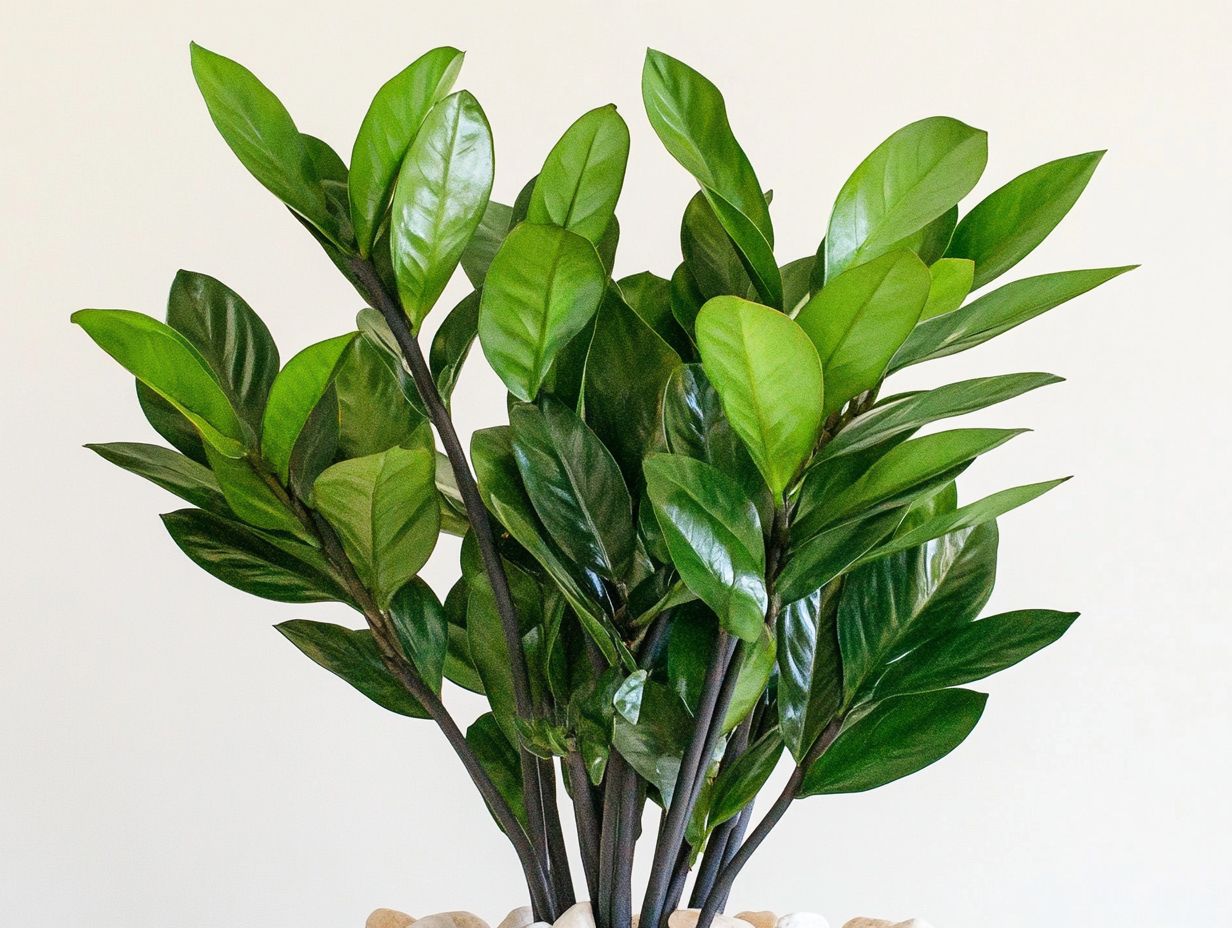
Using a well-draining potting mix is absolutely essential for your ZZ Plants, as their succulent-like roots are prone to rot if they become overly saturated.
Opt for soil specifically designed for succulents or cacti; this allows excess moisture to escape while still providing the essential nutrients your plants need.
This type of soil often features a blend of coarse materials like pumice or perlite, which helps maintain proper aeration.
In terms of fertilization, your ZZ Plants will thrive with a balanced, water-soluble fertilizer during the growing season think every four to six weeks.
A diluted formula is the way to go, ensuring the roots can absorb nutrients without feeling overwhelmed. This careful approach is crucial for fostering robust growth and vibrant foliage.
Common Pests and Diseases
ZZ Plants may encounter challenges from pests like aphids. These can affect their health and appearance, but you can keep these resilient plants thriving.
Besides aphids, ZZ Plants may also face root rot. This occurs from overwatering and can cause yellowing leaves.
To protect against these issues, monitor soil moisture levels carefully. Ensure pots have good drainage and use well-draining soil.
For pest infestations, you can use natural remedies like neem oil. This option is eco-friendly and avoids harsh chemicals.
Benefits of Having ZZ Plants
ZZ Plants not only elevate the aesthetic charm of your indoor spaces, but they also play a vital role in enhancing indoor air quality. This makes them an exceptional choice for households in search of air-purifying plants.
Air Purification and Other Benefits
One of the most remarkable advantages of ZZ Plants lies in their air-purifying prowess, which significantly enhances indoor air quality by filtering out harmful toxins.
With their thick, waxy leaves, these resilient plants are adept at absorbing common indoor pollutants such as formaldehyde, xylene, and toluene. They are an excellent choice for both homes and offices.
Research has shown that these plants can eliminate up to 80% of air toxins in a controlled environment, a benefit that becomes crucial in spaces with limited ventilation.
Keep in mind that environmental factors like light levels and humidity can impact their effectiveness, so positioning them thoughtfully can amplify their contribution to a healthier indoor atmosphere.
Creative Uses for ZZ Plants
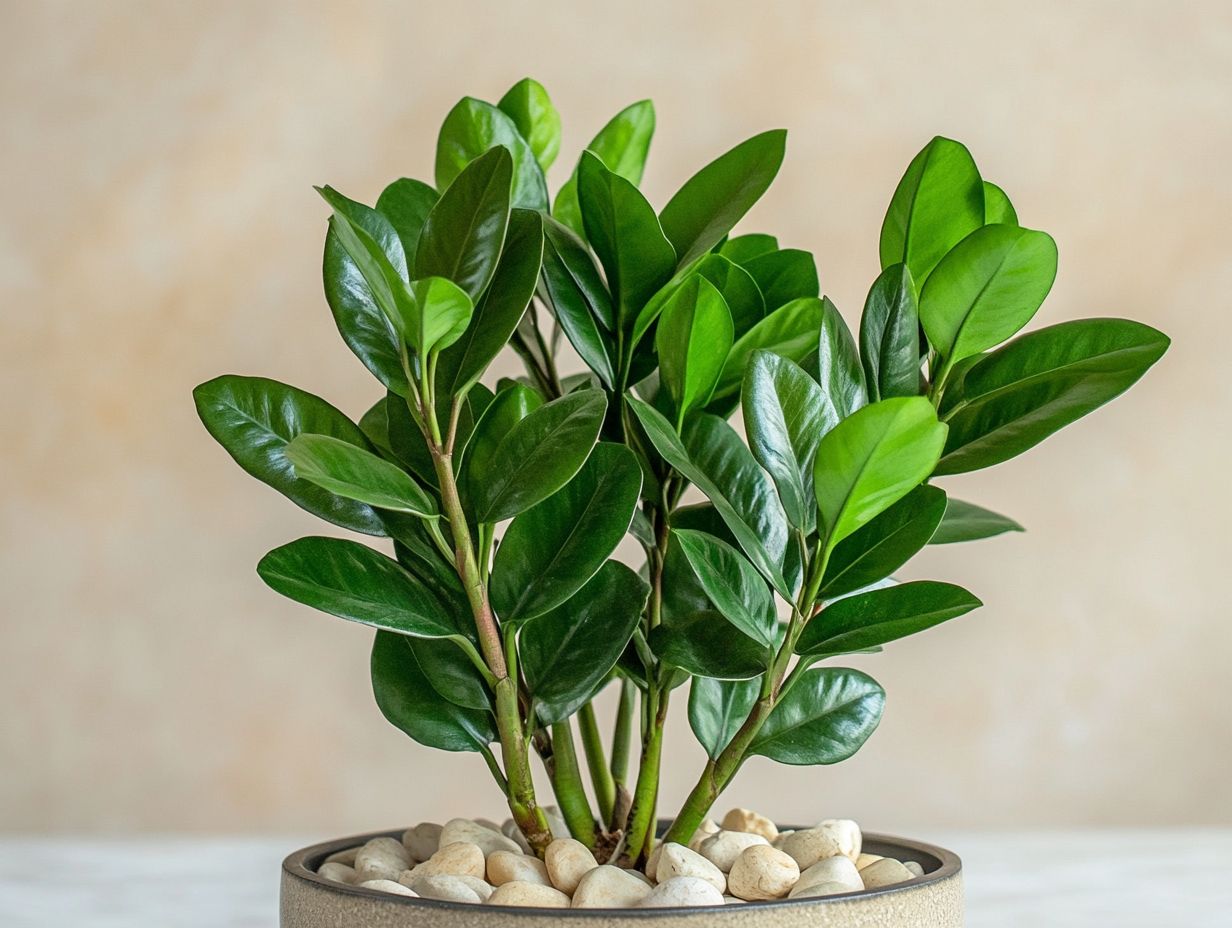
ZZ Plants open up exciting creative opportunities, whether you’re enhancing your home decor or selecting a thoughtful gift. Their versatility and aesthetic charm shine in any setting.
Incorporating ZZ Plants into your indoor decor can truly elevate the ambiance, adding a touch of greenery and sophistication to any room.
These resilient beauties thrive in low light conditions, making them perfect for a variety of spaces, whether it s a cozy corner or a sunny nook by the window.
For a striking visual effect, consider pairing them with trailing vines or mixing in height variations like snake plants. This creates a dynamic display that s sure to catch the eye.
Placing ZZ Plants in decorative pots can take things up a notch, especially when you align them with your chosen interior design style, be it modern minimalist or bohemian chic.
Their appealing structure and glossy leaves not only attract plant enthusiasts but also complement a wide range of furnishings seamlessly. This versatility makes them an excellent addition to your home, adding both charm and character.
Gift Ideas
ZZ Plants are the perfect gift for anyone, thanks to their low-maintenance nature and striking appearance that appeals to both budding and experienced plant enthusiasts.
These resilient beauties thrive in various lighting conditions and require minimal watering, making them an ideal choice for those with busy lifestyles or individuals who may not consider themselves green thumbs.
When you re thinking about gifting a ZZ Plant, take a moment to consider the recipient s personal style.
A sleek ceramic pot can elevate its modern aesthetic for a more formal presentation, while a rustic basket introduces a warm, cozy vibe.
Choosing the right size is also essential; small plants fit beautifully on desks, while larger varieties can become impressive statement pieces in any room.
To truly elevate your gesture, consider adding a heartfelt note, transforming your gift into a memorable experience.
Ready to transform your space with ZZ Plants? Start your plant journey today!
Final Tips and Recommendations
To cultivate a flourishing ZZ Plant, embrace these final tips and recommendations on plant maintenance, addressing all essential aspects of care and attention.
Selecting the ideal location is paramount. The ZZ Plant thrives in low to bright indirect light but should be shielded from direct sunlight to avoid unsightly leaf burn.
Wait until the soil is completely dry before watering again; your ZZ plant will thank you! This resilient species is particularly sensitive to the perils of overwatering.
During the growing season, consider enriching its life with a balanced fertilizer each month to promote robust growth. Pay attention to humidity levels, especially in drier months. A gentle misting or placing the plant on a pebble tray filled with water can work wonders.
Don’t forget to regularly wipe down the leaves to maintain their glossy appearance. This enhances the plant’s ability to breathe, contributing significantly to its overall health and longevity.
Frequently Asked Questions

What is a ZZ plant?
A ZZ plant (Zamioculcas zamiifolia) is a popular houseplant known for its glossy, dark green leaves. It thrives in low light conditions and is highly valued in indoor gardening.
Where are ZZ plants native to?
ZZ plants are native to eastern Africa, specifically in the countries of Kenya, Tanzania, and Zanzibar.
How should I care for my ZZ plant?
The Ultimate Guide to ZZ Plants recommends placing your plant in bright, indirect light. Allow the soil to dry out between waterings. Fertilize every few months during the growing season and repot every 1-2 years.
Can ZZ plants be toxic to pets?
Yes, ZZ plants are toxic to pets if ingested. Keep them out of reach of curious pets or opt for pet-friendly houseplants instead.
What are some common problems with ZZ plants?
Overwatering and low light conditions are the most common issues. Pests like mealybugs, aphids, and spider mites can infest ZZ plants. Yellowing leaves may indicate root rot or other environmental factors that need addressing.
Are ZZ plants easy to propagate?
Yes, ZZ plants can be propagated through stem cuttings or by dividing the root ball. The Ultimate Guide to ZZ Plants recommends using sterile equipment and a well-draining soil mix for successful results.





